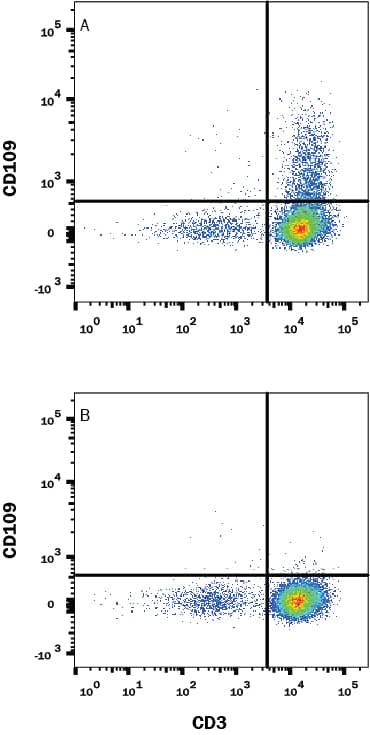Human/Mouse CD109 PE-conjugated Antibody Summary
Val22-Ser1268 (Tyr703Ser & Thr1241Met)
Accession # Q6YHK3
Applications
Please Note: Optimal dilutions should be determined by each laboratory for each application. General Protocols are available in the Technical Information section on our website.
Scientific Data
 View Larger
View Larger
Detection of CD109 in A431 Human Cell Line by Flow Cytometry. A431 human epithelial carcinoma cell line was stained with Mouse Anti-Human/Mouse CD109 PE-conjugated Monoclonal Antibody (Catalog # FAB4385P, filled histogram) or isotype control antibody (Catalog # IC003P, open histogram). View our protocol for Staining Membrane-associated Proteins.
 View Larger
View Larger
Detection of CD109 in Mouse Splenocytes by Flow Cytometry. Mouse splenocytes treated with PMA and Calcium Ionomycin were stained with Mouse Anti-Human/Mouse CD109 PE-conjugated Monoclonal Antibody (Catalog # FAB4385P, filled histogram) or isotype control antibody (Catalog # IC003P, open histogram). View our protocol for Staining Membrane-associated Proteins.
 View Larger
View Larger
Detection of CD109 in Human PBMCs by Flow Cytometry. Human peripheral blood mononuclear cells (PBMCs) treated with 2 ug/mL PHA for 5 days were stained with Mouse Anti-Human CD3e APC-conjugated Monoclonal Antibody (Catalog # FAB100A) and (A) Mouse Anti-Human CD109 PE-conjugated Monoclonal Antibody (Catalog # FAB4385P) or (B) PE-conjugated Mouse IgG2A isotype control (Catalog # IC003P). View our protocol for Staining Membrane-associated Proteins.
Reconstitution Calculator
Preparation and Storage
- 12 months from date of receipt, 2 to 8 °C as supplied.
Background: CD109
CD109 is a GPI-anchored member of the alpha -2-Macroglobulin (A2M) and complement family of proteins (1). Mature human CD109 contains a bait region with recognition sequences for multiple proteases, an internal thioester bond, and a domain similar to the receptor binding domain of A2M (2). Cleavage of A2M family proteins within the bait region activates the thioester bond to promote covalent bonding to nucleophilic groups in adjacent molecules (3, 4). Within the region included in this recombinant protein, human CD109 shares 71-73% amino acid (aa) sequence identity with mouse and rat CD109. It shares 27-33% aa sequence identity with A2M and complement factors C3, C4, and C5. Alternate splicing of human CD109 generates two isoforms with short deletions and one that is truncated within the bait region. CD109 is expressed on activated T cells and platelets, hematopoietic stem cells, megakaryocyte precursors, vascular endothelial cells, basal and myoepithelial cells of secretory glands, and squamous cell carcinomas (2, 5-9). It is produced as a 170-180 kDa glycoprotein that is autocatalytically processed to 150 kDa and 120 kDa forms (2, 6, 10). CD109 on keratinocytes binds TGF-beta and associates with TGF-beta RI and TGF-beta RII, resulting in inhibition of TGF-beta signaling (11). Polymorphisms of CD109 include the platelet-specific Gov antigen and the blood group ABH antigens (12, 13). Alloantibodies directed against these antigens result in unsuccessful platelet transfusions, neonatal alloimmune thrombocytopenia, and posttransfusion purpura (14).
- Travis, J. and G.S. Salvesen (1983) Annu. Rev. Biochem. 52:655.
- Lin, M. et al. (2002) Blood 99:1683.
- Christensen, U. and L. Sottrup-Jensen (1984) Biochemistry 23:6619.
- Wallis, R. et al. (2007) J. Biol. Chem. 282:7844.
- Murray, L.J. et al. (1999) Exp. Hematol. 27:1282.
- Haregewoin, A. et al. (1994) Cell. Immunol. 156:357.
- Hasegawa, M. et al. (2007) Pathol. Int. 57:245.
- Brashem-Stein, C. et al. (1988) J. Immunol. 140:2330.
- Hashimoto, M. et al. (2004) Oncogene 23:3716.
- Solomon, K.R. et al. (2004) Gene 327:171.
- Finnson, K.W. et al. (2006) FASEB J. 20:1525.
- Schuh, A.C. et al. (2002) Blood 99:1692.
- Kelton, J.G. et al. (1998) J. Lab. Clin. Med. 132:142.
- Rozman, P. (2002) Transpl. Immunol. 10:165.
Product Datasheets
Citations for Human/Mouse CD109 PE-conjugated Antibody
R&D Systems personnel manually curate a database that contains references using R&D Systems products. The data collected includes not only links to publications in PubMed, but also provides information about sample types, species, and experimental conditions.
3
Citations: Showing 1 - 3
Filter your results:
Filter by:
-
The immune landscape of murine skeletal muscle regeneration and aging
Authors: Sousa, NS;Bica, M;Brás, MF;Sousa, AC;Antunes, IB;Encarnação, IA;Costa, TM;Martins, IB;Barbosa-Morais, NL;Sousa-Victor, P;Neves, J;
Cell reports
Species: Mouse, Transgenic Mouse
Sample Types: Whole Cells
Applications: Flow Cytometry -
Phenotypic Plasticity of Invasive Edge Glioma Stem-like Cells in Response to Ionizing Radiation
Authors: M Minata, A Audia, J Shi, S Lu, J Bernstock, MS Pavlyukov, A Das, SH Kim, YJ Shin, Y Lee, H Koo, K Snigdha, I Waghmare, X Guo, A Mohyeldin, D Gallego-Pe, J Wang, D Chen, P Cheng, F Mukheef, M Contreras, JF Reyes, B Vaillant, EP Sulman, SY Cheng, JM Markert, BA Tannous, X Lu, M Kango-Sing, LJ Lee, DH Nam, I Nakano, KP Bhat
Cell Rep, 2019-02-12;26(7):1893-1905.e7.
Species: Human
Sample Types: Whole Cells
Applications: Flow Cytometry -
Visualization of Proliferative Vascular Endothelial Cells in Tumors in�Vivo by Imaging Their Partner of Sld5-1 Promoter Activity
Authors: D Yamakawa, W Jia, H Kidoya, S Hosojima, M Torigata, L Zhang, N Takakura
Am. J. Pathol., 2018-04-09;0(0):.
Species: Mouse
Sample Types: Tissue Homogenates
Applications: Flow Cytometry
FAQs
No product specific FAQs exist for this product, however you may
View all Antibody FAQsReviews for Human/Mouse CD109 PE-conjugated Antibody
There are currently no reviews for this product. Be the first to review Human/Mouse CD109 PE-conjugated Antibody and earn rewards!
Have you used Human/Mouse CD109 PE-conjugated Antibody?
Submit a review and receive an Amazon gift card.
$25/€18/£15/$25CAN/¥75 Yuan/¥2500 Yen for a review with an image
$10/€7/£6/$10 CAD/¥70 Yuan/¥1110 Yen for a review without an image
